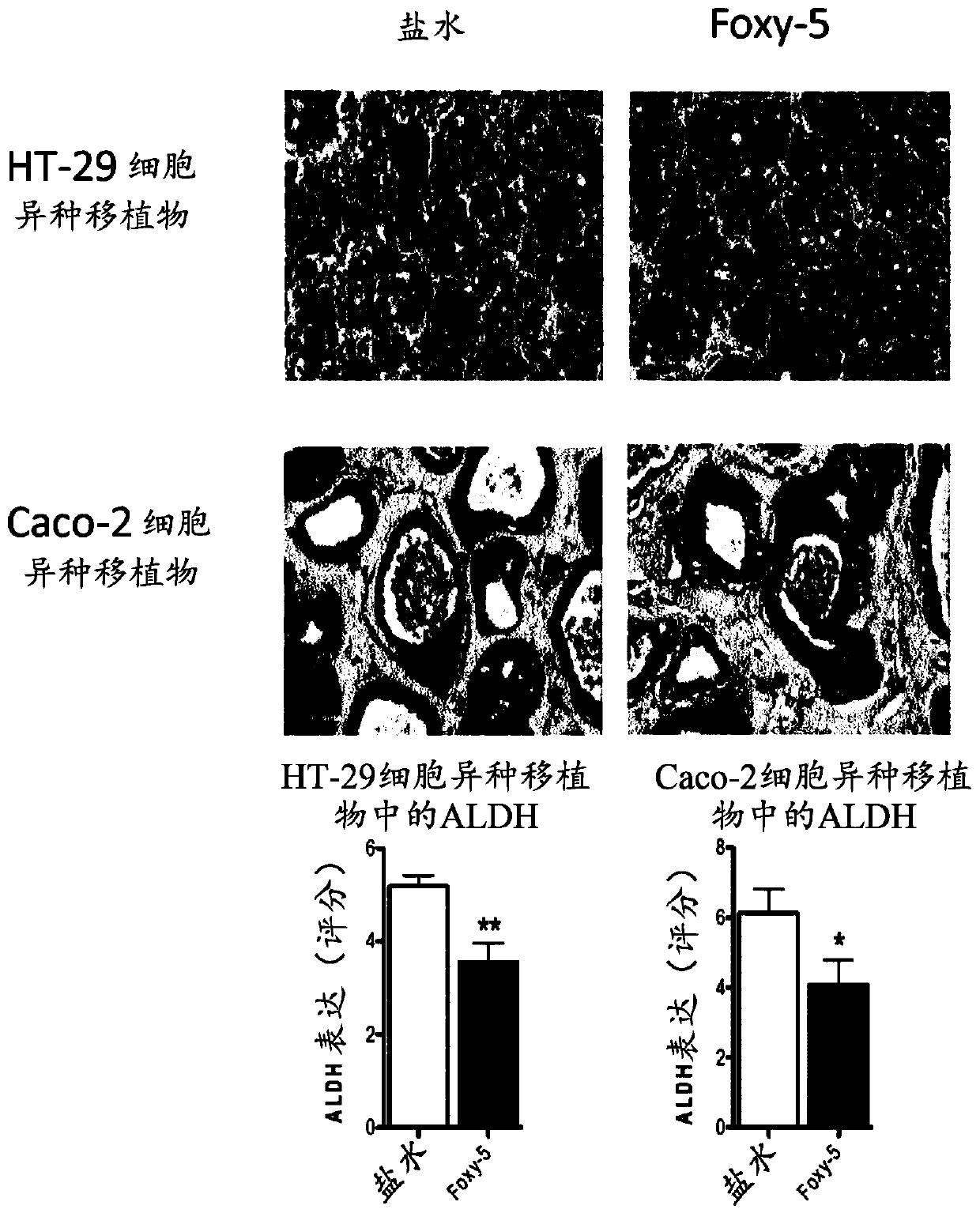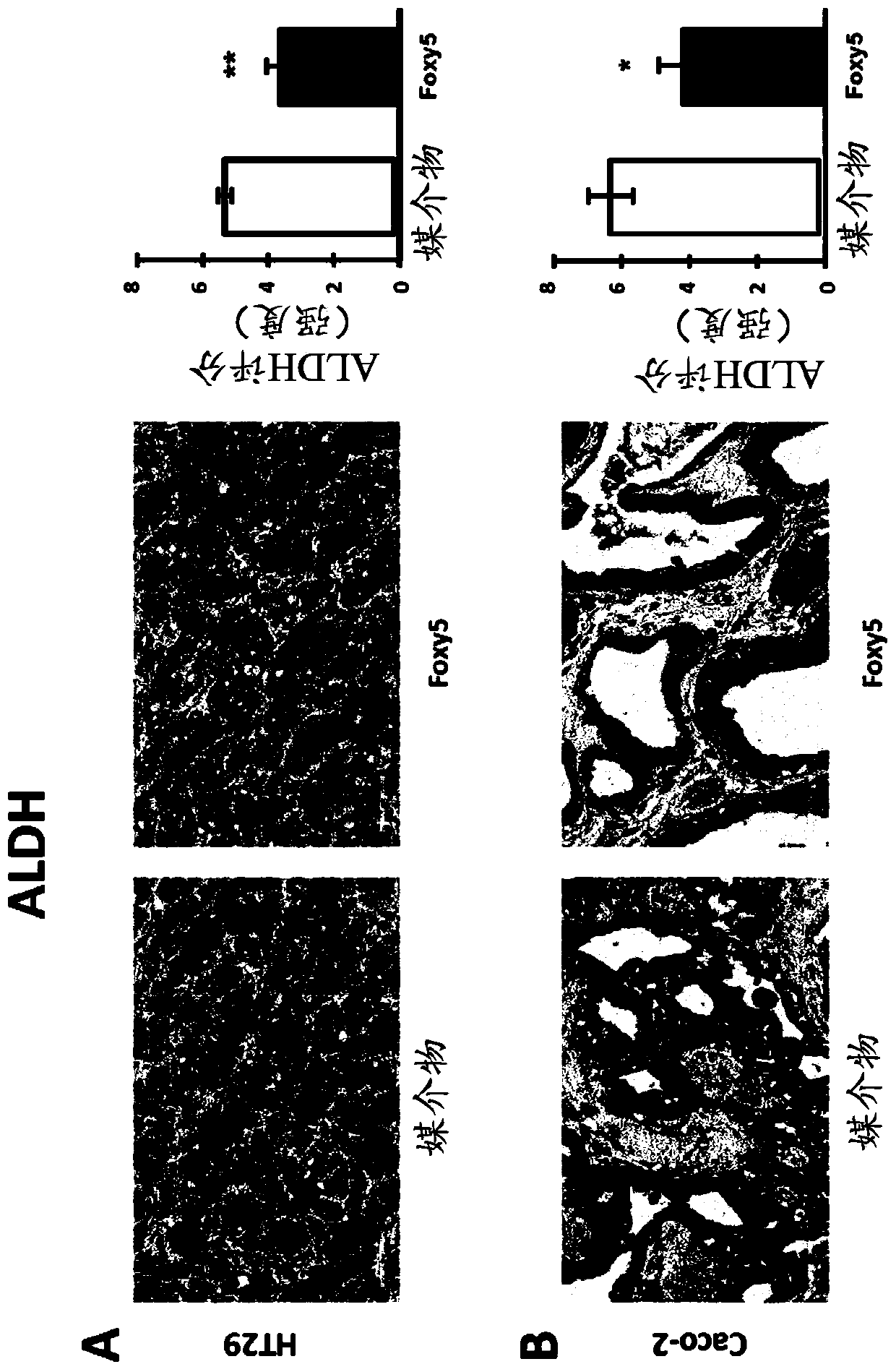Wnt5a peptides in reduction of cancer stem cells
A cancer stem cell and cancer technology, applied in the direction of medical preparations containing active ingredients, peptide sources, animal/human peptides, etc., can solve problems affecting stem cells, increase side effects, and improve cancer treatment effects
- Summary
- Abstract
- Description
- Claims
- Application Information
AI Technical Summary
Problems solved by technology
Method used
Image
Examples
Embodiment 1
[0093]Tumors from two different human colon cancer cell types, HT29 and Caco-2 cells, were examined by immunohistochemistry (IHC) and mRNA (see figure 1 ).
[0094] On day 0: HT29 or Caco-2 colon cancer cells were injected subcutaneously in nude mice.
[0095] On day 7 after tumor establishment in mice, vehicle (saline) alone (gr 1 ) or Foxy-5 (2 μg / g; gr 2) was injected intraperitoneally (I.P).
[0096] Tumor growth and animal body weights were monitored on days 9-23 - then +8 I.P. injections of vehicle alone (gr 1 ) or Foxy-5 (2 μg / g; gr 2) every two days.
[0097] On day 24, two types of tumors (Caco-2 and HT29-derived) (divided into two fractions, one of which was fixed and the other frozen at -80°C) were analyzed by IHC for COX-2, 15PGDH, Protein expression of β-catenin, Ascl2, ALDH and Dckl1 and their mRNA contents of ALDH and Dckl1 (ALDH is a general stem cell marker and Dck1 is a specific marker of colonic CSCs).
[0098] Foxy-5 was shown to significantly reduce the...
Embodiment 2
[0100] For further verification Figures 2 to 4 Based on the findings outlined in, we analyzed the possible mechanisms responsible for the reduction in CSC numbers in this experiment. In colon cancer, the cyclooxygenase 2 (COX-2) enzyme is frequently upregulated. COX-2 activity leads to the production and release of prostaglandin E2 (PGE2). PGE2 promotes cancer progression and was shown to favor the expansion of colonic CSCs. (Wang et al., Prostaglandin E2 promotes colorectal cancer stem cell expansion and metastasis in mice[Prostaglandin E2 promotes colorectal cancer stem cell expansion and metastasis in mice]. Gastroenterology [Gastroenterology] 149:1884-1895, 2015) . While perturbation of the canonical WNT signaling pathway is thought to be the cause of colorectal tumors, the increased expression of cyclooxygenase 2 (COX-2) that occurs in most colorectal tumors is thought to play a role in colorectal cancer development. Crucial role. Increased COX-2 expression leads to...
Embodiment 3
[0102] The in vivo effects of Foxy-5 treatment on β-catenin signaling in HT-29 or Caco-2 colon cancer tissues may be another possible explanation for the observed reduction in CSC numbers. A reduction in the amount of active β-catenin nuclear expression was observed in both Caco-2 and HT29-derived colon cancer tumors as a result of Foxy-5 treatment (see Figure 7 with 8 ). The observation of decreased β-catenin signaling by Foxy-5 was confirmed by a reduction in tumor volume ( Image 6 with 7 ). Essential to this study is the fact that a Foxy-5-induced decrease in the β-catenin downstream target Ascl2, a transcription factor that promotes the cancer stem cell niche, was also observed, indicating the ability of Foxy-5 treatment to reduce CSC numbers Also depends on reduced β-catenin / Ascl2 signaling (see Figures 6 to 9 ). Thus, the Foxy-5 peptide exhibits the unique property of reducing CSC numbers through its ability to target three distinct elements (COX-2, 15-PGDH, and...
PUM
 Login to View More
Login to View More Abstract
Description
Claims
Application Information
 Login to View More
Login to View More - R&D
- Intellectual Property
- Life Sciences
- Materials
- Tech Scout
- Unparalleled Data Quality
- Higher Quality Content
- 60% Fewer Hallucinations
Browse by: Latest US Patents, China's latest patents, Technical Efficacy Thesaurus, Application Domain, Technology Topic, Popular Technical Reports.
© 2025 PatSnap. All rights reserved.Legal|Privacy policy|Modern Slavery Act Transparency Statement|Sitemap|About US| Contact US: help@patsnap.com



